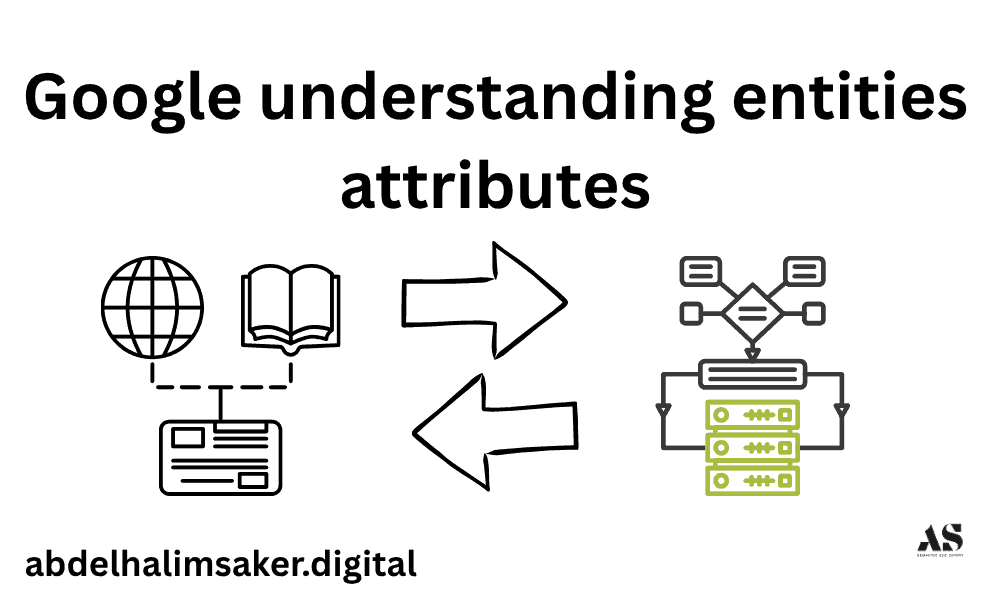
Google understands entities and attributes by analyzing how meaning is expressed through structured and unstructured data.
An entity represents a distinct concept (person, place, object, event, or idea).
An attribute represents a characteristic, relationship, or property that defines the entity.
Google’s search algorithms use these relationships to interpret contextual meaning, enabling it to rank pages based on semantic precision, not just keyword repetition.
By identifying entities and their attributes, Google converts language into machine-readable meaning graphs — the foundation of semantic SEO and the Knowledge Graph.
Entity Recognition and Disambiguation
Google performs entity recognition and disambiguation to identify which entities appear in a text and what each one means within context.
These two processes ensure that every concept in content maps correctly to its real-world counterpart.
Named Entity Recognition (NER)
Named Entity Recognition (NER) is Google’s process of detecting named entities within unstructured text.
NER identifies whether a term refers to a person, brand, location, organization, or object.
Example:
Sentence: “Elon Musk founded SpaceX in California.”
NER identifies:
- Elon Musk → Person
- SpaceX → Organization
- California → Location
Semantic triples:
- (Elon Musk) → (founded) → (SpaceX)
- (SpaceX) → (located in) → (California)
These triples form atomic meaning units that machines can understand.
NER systems use context windows, linguistic tagging, and probabilistic models to ensure accuracy.
Key mechanisms Google employs:
- Token classification — segmenting sentences into labeled units.
- Part-of-speech tagging — identifying nouns, verbs, and adjectives.
- Entity linking — connecting recognized entities to Knowledge Graph IDs.
Why it matters for SEO:
When your content consistently references entities that Google already recognizes (e.g., through schema markup or consistent naming), it strengthens topical relevance and improves ranking consistency.
Entity Disambiguation and Context Boundaries
Entity disambiguation is the process of determining which version of an entity a text refers to when multiple meanings exist.
Example:
- Apple → Could mean a fruit or a technology company.
Google resolves ambiguity using context boundaries — surrounding text that clarifies meaning.
Example of disambiguation:
Sentence: “Apple released a new version of iOS.”
Context boundary includes iOS (software), so Google interprets Apple as the company, not the fruit.
Techniques used:
- Contextual embeddings — models like BERT analyze the position and relation of words.
- Co-occurrence probability — measuring how often terms appear together across the web.
- Entity co-reference resolution — linking pronouns and references (“it,” “they”) back to the correct entity.
Semantic triple examples:
- (Apple Inc.) → (releases) → (iOS 19)
- (Apple fruit) → (contains) → (vitamin C)
Entity disambiguation ensures Google indexes the correct meaning within each domain context.
This process directly affects content classification, search snippet accuracy, and ranking precision.
Attribute Extraction in Semantic SEO
Attribute extraction is how Google identifies the descriptive properties or relationships of an entity.
Attributes act as the qualifiers that specify or measure the entity’s nature.
In semantic SEO, attributes include:
- Adjectives (color, size, quality)
- Verbs (actions associated with entities)
- Relational phrases (part of, located in, used by)
Example:
Sentence: “Tesla Model 3 is an electric sedan manufactured by Tesla.”
Google identifies:
- Entity: Tesla Model 3
- Attributes: electric, sedan, manufactured by Tesla
Semantic triples:
- (Tesla Model 3) → (is) → (electric sedan)
- (Tesla Model 3) → (manufactured by) → (Tesla)
Each attribute provides dimensional meaning, enabling Google to position content accurately within the knowledge domain.
How Google Derives Attributes from Text
Google uses dependency parsing and semantic role labeling to understand the function of words in a sentence.
It detects patterns such as:
| Predicate | Example | Extracted Attribute |
|---|---|---|
| has color | “Bananas are yellow.” | Yellow |
| was founded by | “Google was founded by Larry Page.” | Larry Page |
| is part of | “SEO is part of digital marketing.” | Digital Marketing |
These patterns form the attribute-value pairs stored in the Knowledge Graph.
In SEO terms:
Attributes define why a piece of content matches a search query.
For instance, a query “fastest electric car” triggers retrieval of entities labeled with attributes [electric] and [fastest speed].
How Google Uses Knowledge Graphs
The Knowledge Graph is Google’s semantic database that organizes information through entity–attribute–value relationships.
It connects entities into a vast web of relationships, allowing Google to infer meaning even when not explicitly stated.
Structure of the Knowledge Graph
| Element | Description | Example |
|---|---|---|
| Entity | The main concept | Tesla Model 3 |
| Attribute | A defining property | Battery Capacity |
| Value | The specific measurement or description | 82 kWh |
Example of a Knowledge Graph triple:
- (Tesla Model 3) → (has battery capacity) → (82 kWh)
The Knowledge Graph connects millions of such triples to form conceptual networks.
When users search for “Tesla range,” Google retrieves entities where the attribute “range” aligns with Tesla models.
Knowledge Graph Sources
Google populates its Knowledge Graph from:
- Structured data — Schema.org, Wikidata, and official databases.
- Unstructured text — Web pages, articles, and user-generated content.
- Human curation — Data from Google Knowledge Panels and Wikipedia editors.
Google’s machine learning models constantly synchronize structured and unstructured inputs to maintain contextual accuracy.
Why the Knowledge Graph Matters for SEO
A page’s ranking potential increases when its content mirrors the structure of the Knowledge Graph.
That means your content must clearly define:
- Who or what the entity is
- Which attributes describe it
- How those attributes relate to other entities
Example in practice:
If your page covers “Solar Panels,” Google expects:
- Entity: Solar Panel
- Attributes: Efficiency, Material, Manufacturer, Wattage, Cost per Watt
Providing this structure increases entity relevance and strengthens topical authority.
Why Attributes Define Query Relevance
Attributes define query relevance because they match the descriptive context of what users seek.
When a user enters a query, Google extracts attribute tokens from it and compares them to entity attributes in its index.
Example:
Query: “cheap hotels in Amsterdam with free parking”
Google breaks it into:
- Entity: Hotels in Amsterdam
- Attributes: cheap, free parking
The algorithm then retrieves entities that match these attribute-value pairs.
That’s why a page titled “Affordable Amsterdam Hotels with Free Parking” ranks higher — it matches both entity and attribute vectors.
How Attribute Matching Works
- Query Attribute Parsing — Google detects adjectives and relational terms in the query.
- Entity Matching — Google filters entities with relevant attribute tags.
- Contextual Scoring — It ranks results by attribute precision and trustworthiness.
Semantic triple:
- (Query attributes) → (filter) → (relevant entities)
Impact on Ranking Precision
Pages that express attributes clearly — through structured headings, schema, and factual phrasing — help Google align meaning faster.
This reduces retrieval cost and increases ranking stability.
Example:
A product page stating, “Battery life: 14 hours” creates an attribute-value pair Google can parse directly.
Ambiguous text like “long battery life” provides weaker signals.
Optimizing Content for Better Entity Understanding
Improving how Google understands your entities and attributes requires aligning content architecture, schema markup, and semantic writing patterns.
This alignment ensures your site functions as a structured knowledge system, not just a collection of articles.
1. Use Schema Markup to Define Entities and Attributes
Schema.org provides structured vocabularies that express entities and attributes explicitly.
Example schema snippet:
{
"@context": "https://schema.org",
"@type": "Product",
"name": "Tesla Model 3",
"brand": "Tesla",
"vehicleEngine": {
"@type": "EngineSpecification",
"engineType": "Electric",
"power": "283 hp"
},
"fuelType": "Electricity",
"offers": {
"@type": "Offer",
"price": "42990",
"priceCurrency": "USD"
}
}
This schema communicates clear attribute relationships to Google, strengthening entity disambiguation and improving how your pages appear in rich results.
2. Build Internal Links Around Entity Relationships
Internal links act as semantic bridges that define how entities relate to each other.
Use descriptive anchor text that mirrors the attribute or relationship between pages.
Example:
- “See our [electric car range comparison]” → links from Tesla Model 3 page to an electric vehicle guide.
- “Learn about [battery efficiency metrics]” → links to attribute-specific analysis pages.
This structure creates horizontal semantic connectivity, signaling to Google that your site maintains coherent topical organization.
3. Write Using Semantic Triples
Every sentence should ideally express a clear relationship between a subject, predicate, and object.
This structure helps NLP models detect attribute logic easily.
Example:
- (Solar panels) → (convert) → (sunlight into electricity)
- (Lithium batteries) → (store) → (energy for later use)
Using objective predicates like “convert,” “store,” “generate,” and “measures” increases machine readability and minimizes ambiguity.
4. Organize Content Using Attribute-Based Headings
Structure content so that each heading reflects a specific attribute category.
For example, in a product article:
| Heading | Attribute Type | Example |
|---|---|---|
| “Battery Life” | Performance | 14 hours |
| “Charging Time” | Functional | 30 minutes |
| “Safety Rating” | Quality | 5 stars |
This not only improves user comprehension but also provides semantic segmentation that search engines use to extract information snippets.
5. Maintain Consistent Entity Naming
Use consistent entity names across all pages, schema, and metadata.
Inconsistencies (e.g., “Tesla Model 3” vs. “Model 3 Sedan”) create semantic fragmentation, which weakens entity recognition.
Google’s systems rely on consistency to merge mentions into unified knowledge graph nodes.
6. Integrate Attribute-Based Metadata
Use metadata fields like meta descriptions, Open Graph tags, and image alt text to reinforce attributes.
For example:
- Meta description: “Explore Tesla Model 3’s 82 kWh battery and 358-mile range.”
- Image alt text: “Tesla Model 3 front view electric sedan.”
Each instance adds to Google’s attribute confidence score.
How Entity Understanding Connects with Topical Authority
Google’s ability to interpret entities and attributes directly affects topical authority scoring.
Topical authority increases when a domain provides:
- Consistent entity coverage across multiple related topics.
- Attribute-rich explanations that define context clearly.
- Interconnected relationships reflecting real-world structures.
Example of an authority network:
- Entity: “SEO”
- Attribute 1: “Query Semantics”
- Attribute 2: “Contextual Hierarchy”
- Attribute 3: “Historical Data”
Covering each of these attributes in dedicated, interlinked content pieces creates macro-level semantic completeness.
Behavioral Validation of Entity Relevance
When users engage longer with entity-rich content, Google interprets it as a confirmation signal for meaning accuracy.
Positive behavioral data — high dwell time, low bounce rate — reinforces entity trust within Google’s model.
Thus, behavioral and semantic signals together determine ranking endurance.
Example: Entity–Attribute Optimization in Practice
Case: A page about “Canon EOS R5 Camera.”
Step 1: Identify the Main Entity
- Canon EOS R5 → Entity type: Product
Step 2: Extract Core Attributes
- Resolution: 45 MP
- Sensor: Full-frame CMOS
- ISO range: 100–51200
- Video capability: 8K
Step 3: Structure Content Accordingly
- H1: Canon EOS R5 Review
- H2: Key Specifications (attributes)
- H2: Image Quality and Performance (attribute evaluation)
- H2: Video Features (attribute comparison)
Step 4: Apply Schema and Internal Linking
Add Product schema, link to “Best Full-Frame Cameras” and “8K Video Cameras” pages.
Result:
Google indexes each attribute as a distinct vector, increasing appearance in feature snippets and comparison results.
The Future of Entity and Attribute Understanding
Google continues to evolve toward multimodal entity understanding, integrating text, image, and video data into unified meaning graphs.
Emerging trends include:
- Multimodal embedding models — connecting visual attributes (color, shape) with textual entities.
- Dynamic attribute learning — updating attributes as new information appears online.
- Conversational context retention — recognizing entities across multiple user interactions (as in Google SGE).
Future SEO will require continuous entity calibration — keeping content synchronized with evolving attribute meanings.
